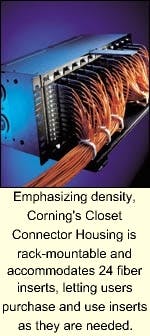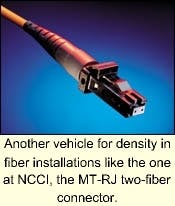The NCCI chooses fiber-to-the-desk when consolidating offices into a campus.
The National Council on Compensation Insurance (NCCI), a provider of insurance-compensation information and services to the insurance industry, recently completed one of the nation's largest commercial fiber-to-the-desktop projects. With more than 800 employees and extensive database management and distribution requirements, NCCI needed to design, implement, and maintain some of the most sophisticated network systems found anywhere.
In 1998, NCCI began developing its plans to consolidate multiple office locations into a single corporate campus in Boca Raton, FL. The network design team for NCCI realized that the cabling plant for the new facility needed to support the company's complex and diverse communication requirements and its evolving high-bandwidth applications. NCCI uses 100Base-T and Gigabit Ethernet to distribute information across the local area network (LAN). Traffic includes file transfers, e-mail, video conferencing and proprietary applications. Future demands may include voice-over-Internet Protocol (VoIP), video streaming, and Gigabit Ethernet to the desktop.
Penny Pshonick, NCCI's senior project manager for network cabling and infrastructure, managed the project. "We wanted a cabling plant that would provide an infrastructure for our high-bandwidth communication requirements and support future migration to multimedia desktop applications," she explained.
The Presidio Corporation (Lanham, MD; www.presidio.com) provided a turnkey solution that included bandwidth assessment, CAD engineering, request-for-proposal development, and bid evaluation. The Presidio Corporation also provided structured cabling project management services during the construction phase.
In addition, the company developed the cabling plant design and layout based on NCCI's detailed system requirements. After evaluating the many cabling options, NCCI elected to install a fiber-to-the-desktop infrastructure as part of its horizontal distribution system. While Category 5E and Category 6 cables service the workstations, a fiber-to-the-desktop architecture was included to provide a migration path with significantly enhanced bandwidth capabilities when compared to the copper links.
"The design goal was to provide an infrastructure with sufficient bandwidth for a 15-year building life, without recabling," said Jerry Baggett, RCDD/LAN specialist, director of structured cabling for The Presidio Corporation.
Design considerations
With the design capabilities provided by The Presidio Corporation, NCCI developed the communications plans and scope of work for the architect and interior-design firms to build the new campus. The new building was designed to support more than 900 multiport workstations, with more than 1,850 station outlets located throughout the entire facility. The three-story, three-wing building with 323,000 square feet and a 19,000-square-foot data center required that the cabling system plans be integrated into the overall architectural drawings.
The cabling system, consisting of primary and secondary optical pathways, and horizontal distribution to 16 communications closets and more than 1,850 outlets, required creativity and a thorough knowledge of the specifications in the ANSI/EIA/TIA-569 Commercial Building Standard for Telecommunications Pathways and Spaces. The routing and installation methods incorporated conduits, cable trays, and support hooks-all of which needed to be blended into limited space allocations in the plenum and atrium areas.
The pathway scheme, combined with the aggressive installation schedule, offered a difficult task. The center of concern was that the optical-fiber connections, from the network room to the data closets and from the closet to the workstation, would not be completed by the scheduled deadline. But thanks in large part to trained installers and state-of-the-art components, the installation schedule was successfully met.
The complete structured cabling solution consists of a hybrid media infrastructure, which lets NCCI take advantage of lower-cost components for current network demands while having extra bandwidth provided by optical connectivity to the desktop for future applications. This system gives NCCI a complete optical pathway from the network room, which functions as the main crossconnect, to the work area.
In the backbone
The backbone data-communications cabling includes a primary and secondary cable connection to each of the 16 data closets located throughout the campus. The backbone cable comprises 24, 62.5/125-micron multimode and 12 singlemode fibers. Primary connections are routed from the network room through dedicated conduit pathways to each telecommunications closet.
Each closet is also connected to backup switching equipment in the network room, using a secondary optical-backbone system. This secondary link is routed through a separate physical pathway, as far away from the primary link as possible. A 24-multimode-/12-singlemode-fiber cable is also used for this redundant connection. In all, more than 25,000 feet of this cable has been installed to provide a high reliability service to all floors in all wings.
Terminated backbone cables are housed in Corning Cable Systems' Closet Connector Housing (CCH) rack-mountable patch panel with 24-fiber panel inserts. This configuration lets NCCI make efficient use of space, because 288 fibers are terminated in only four units of rack space, providing density not available with other conventional connector system designs. In all, more than 1,150 of Corning Cable Systems' UniCam MT-RJ connectors were installed for backbone connectivity.
In the horizontal
The desktop connection was achieved by using Corning Cable Systems' plenum-rated cable, containing Infinicor 300 fiber, with a 62.5/125-micron core and a bandwidth of 200/500 MHz/km. Corning Cable Systems' cable was bundled with the copper UTP voice and data cables and routed to each of the outlets located at workstations, conference rooms, lobbies, and training facilities on the NCCI campus.
All the fiber cable is terminated to UniCam MT-RJ connectors. Throughout the campus, more than 3,300 terminations were performed for each connector type. The outlet faceplate designs used either a four-port furniture bezel or a flush-mount modular wall faceplate. Each of these faceplates worked well to combine the optical and copper ports at the work area.
The communications-cable closets, which function as intermediate crossconnects, provide for the termination and crossconnection to the backbone circuits. The optical connections were made using Corning Cable Systems' LANscape Solutions CCH-O4U housing and 24-fiber MT-RJ connector panel inserts.
This product system provides a simple and logical approach to connector bank layout and cable management. The use of CCH-O4U panels with 12-connector, 24-fiber MT-RJ connector inserts reduces space requirements for optical connectivity when compared to conventional connector systems, such as the SC and other small-form-factor designs. The cables are separated into voice, copper-based data, and optical-based data groups for ease of management. They are then distributed from the rack to the cable-tray system, which supports the cables to the work areas serviced by the communications closets.
Through technological advancements, NCCI is ready for the future. With a cabling infrastructure that will support current and future plans for network expansion, NCCI exemplifies true preparedness. The diligent planning and excellent support by everyone involved resulted in what will be a highly reliable communications system for many years to come.
David Hall is manager of private-network marketing plans and systems for Corning Cable Systems (Hickory, NC). Andy Jackson is Southeastern regional manager of private networks.



